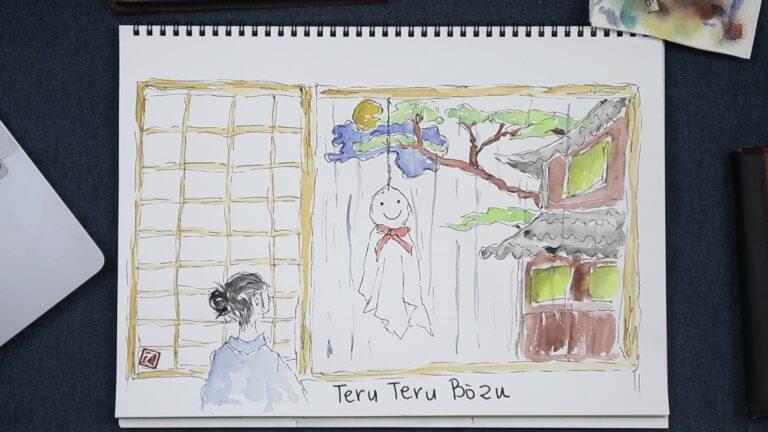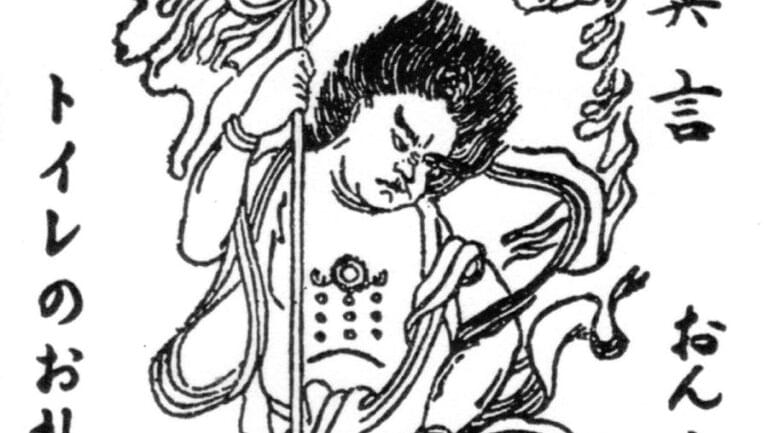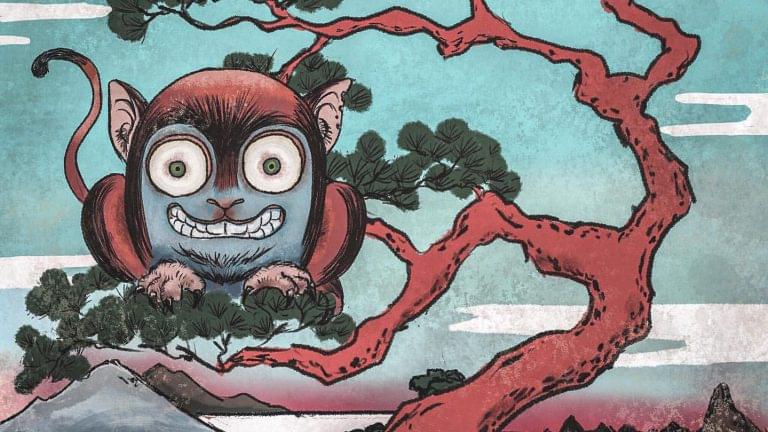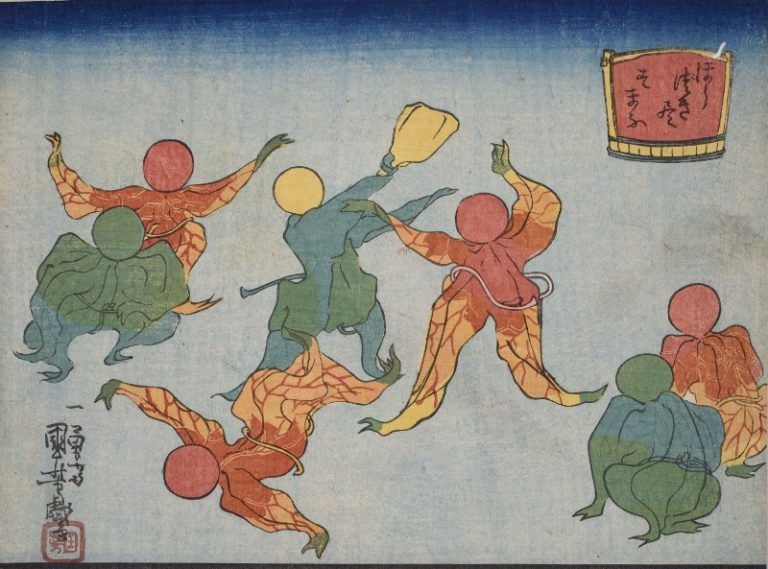Why is the beautiful Spider lily also called a corpse flower? Why didn’t samurai keep camellias in their gardens? Why do Japanese ghosts like to hang out under weeping willows? In this episode of Uncanny Japan I’ll take on a few more Japanese superstitions, but this time plant and flower-related stories.
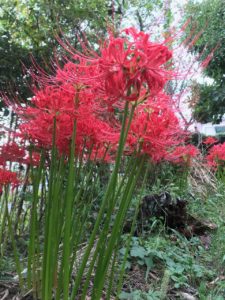
Hey, hey, everyone. It’s October in Japan. There’s a Japanese proverb that goes, “atsusa, samusa mo higan made,” or, “heat and cold last only until the equinoxes.” This year’s autumnal equinox period started on September 20th and lasted until the 26th. So even though it was really hot before the 20th, if we’re to believe the ancient wisdom, the weather should have cooled off since then. I won’t say it’s October weather yet, but the mornings and evenings are a little bit more pleasant. The rice is all golden, tasseled and being harvested in earnest, while hundreds of bright red spider lilies are popping up everywhere. Oh, also, the consumption tax was just raised from eight to 10 percent, which explains other big crowds in hoarding of toilet paper over the weekend.

Higanbana (Spider Lilly)
But let’s back up to the spider lilies or cluster amaryllis. Today, I’m going to talk about superstitions again. So let’s start with the spider lily or higanbana. Remember the proverb about the Equinox? Well, that’s one of the names these gorgeous crimson flowers go by. Higanbana, or equinox flower, because of course, they seemingly shoot up overnight right around the time of the eternal equinox. But they have so many other peculiar names. Here are a few: The red magic lily, hurricane lily, ghost flower, snake flower, razor flower, fox flower, abandoned child flower, resurrection flower, hell flower, and dead man, or corpse flower. It said that there are over a thousand different names from all over Japan for this one flower. And as you can tell, some of them are quite bleak. Corpse flower?
Despite the bad rap they get, I personally really like them. They’re usually deep red, although sometimes you can find these off white colored ones and purple ones too. They grow super fast and they’re all spindly and otherworldly.
Let me tell you a dark old wives tale about the higanbana. I knew about this, but just today I was talking to one of my young students about them and I like her version better. So I’ll tell you that when she came in commenting on how there were no spider lilies last week and now there are hundreds and hundreds everywhere. And wasn’t that weird? I asked her what she thought of them and she said she really like them, except that her mother warned her never to bring any home. I asked why, and she said, “If you snap them off and take them home, they’ll get angry and they’ll set your house on fire or that your mom will die.” Which is good enough reason for a mother to discourage her children from bringing in bouquets of them.
Some believe they’re so bad luck that you’re not even to go near them, much less touch them. They’re often associated with death, the afterlife and hell.
The bulbs are extremely poisonous. And I’ve read that long, long ago, they were planted purposely all around Japanese rice fields in order to keep out mice, moles, and insects. Some people note that moles are carnivores, so they wouldn’t care if a toxic root was nearby. But the reason they work for moles is that the bulbs repel earthworms and no earthworms means no moles.
It’s also said that they were planted in graveyards way back before bodies were cremated. And again, it was the poison in the bulbs that kept away animals that might dig up the dead. So even today, around the autumnal equinox, all around the rice fields and in the graveyards, you can see these beautiful spider lilies popping up.
An interesting aside is even though they are extremely poisonous, they are very starchy and the toxic component is water soluble. So again, back in the day, if you did a lot of soaking and water changing, the bulbs were actually consumed in times of famine, like during World War II. But do note, don’t eat the bulbs or any part of the flower, even though they’re very beautiful, and red and spindly and otherworldly. Just don’t eat them.
So it’s customary during the higan period for people to pay visits to their ancestors’ graves. Indeed, higan means “the other shore” or “the other side.” So the word higan is associated with death or the afterlife. A kind of black joke about the name higanbana is not that it means the equinox flower, but that if you eat one, the only thing that awaits you is higan, or, the afterlife. Another, and nicer, name for the higanbana is manjushage or manjusaka. It seems these blooms were mentioned in a Buddhist sutra where they were described as being white. Because of this, some people called the red ones. higanbana and the white ones manjushage. Anyway, if you’re ever in Japan during the autumnal equinox, do keep an eye out for these beautiful flowers.
Saru-suberi
OK, let’s move on. In my old house, right before it was built, my yard was mostly still dirt and rock, when suddenly this lone plant started to grow on the side of the garden. I thought it was kind of cute. I wasn’t really good at telling weeds from flowers back then. Then one day my mother-in-law came by and I was sure she was going to reprimand me for not weeding properly. But instead she marveled at the plant. She asked where I bought it. I said I didn’t buy it. It just popped up. She called it a saru-suberi and told me that a bird must have brought it for me. I imagined a bird poking the seed into the earth with its beak and tamping down the dirt with its feet. She corrected me by saying it came via the other end of the animal. Ah, yeah.
So after that, I learned saru-suberi in Japanese means something like “the monkey slips.” It’s named because the bark of the tree is such that even a monkey is trying to climb would slide down. In English, it’s a “crape myrtle.” These plants are loved in Japan, especially, I was told, because they bloomed throughout the summer.
Another name for them is the hyakujitsuko, or “blooming for 100 days.” But they’re not completely innocuous. Because of their name, you must never give one as a gift to someone who has just received a promotion or a student who is studying for entrance exams. The word suberu, which means “to slide,” also has the image of failing.
Tsubaki (Camellia)
Another adored flower in Japan that has a love/hate thing going for it is the tsubaki, or camellia. While beautiful and found in the lucky colors of red and white, there is one particularly unlucky thing about the tsubaki at least for samurai back in the day. If you’ve ever noticed when a camellia flower withers, it doesn’t drop petals in a delicate shower like cherry blossoms do. Instead, the entire bloom drops off the stem bottom. Bot-ton. And this, some observant person noticed, can be seen as a metaphor for someone losing their head, which is what happened when seppuku was performed in the ritual, the samurai cuts his stomach while nearby stands a kaishakunin, or his second, with his sword raised, ready to decapitate him. I’ve read tsubaki were never found in a samurai’s garden because of this ominous superstition.
Hiiragi (Holly)
Holly is called hiiragi in Japanese and it’s quite auspicious. The prickly leaves are believed to repel oni, or ogres, and keep away evil in general. People plant them on the northeasterly direction of their property. If you listen to Episode 11, you’ll remember that’s the kimon, or Devil’s Gate. Another thing I briefly mentioned in Episode 11 was the back devil’s gate or urakimon. Well, Japan has a plant for that, too. There is another red berry producing bush called the nanten or nandina in English. Nandina actually derives from the Japanese word nanten. Sometimes it’s called heavenly or sacred bamboo. The name nanten has two characters. The first one means “south (南),” the second “heaven (天).” However, the same word with different kanji could mean “difficulty (難)” and “roll (転).” The image being rolling over difficulty. Nan wo tenjiru (難を転じる), in Japanese. During the Edo era, the superstition was if you planted it in your yard, it would keep away fires. It became popular to then plant them near the entrance of your home. If you pair nanten with fukujusou (adonis flower), it has the meaning of turning a disaster into something fortunate.
Shidare Yanagi (Weeping Willow)
Now I can’t end without giving a nod to ghostly Japan. If you know anything about Japanese ghosts in art and literature, you’ll probably have seen or read about the connection between the shidare yanagi, or weeping willow, and ghosts. Here are some things I found out. Willows used to be planted a lot on the banks of rivers because the roots held the soil type and stopped erosion. Also, if the water rose, the roots wouldn’t rot easily. And also, ghostly women are often seen floating about under the long branches. Back in the Edo era, there was a book of drawings called ehon hyaku monogatari, and in it was a picture titled Yanagi Onna, The Willow Woman. In the picture you can see a woman with long hair dressed in a kimono, holding a baby under the weeping willow. The story behind the drawing was that she was out walking on a windy day and got caught up in the branches of the tree. They ended up strangling her and she died. After that, she continued to haunt the spot, holding the baby.
There is this other thing I read about the yin and yang of things. Willows are yang and they are planted to neutralize the spirit or yin given off by ghosts. I read that willows and ghosts to go together like yin and yang, or like sanma and daikon oroshi or mackerel and grated daikon radish.
And finally, since we’re talking about superstitions and flowers and plants, let me tell you one of the biggies. When you’re bringing flowers to someone who’s sick in the hospital, never give anything that’s in a pot or planted in soil. The idea is ne ga tsuku (根が付く) or “the roots will take hold,” meaning that the roots of the disease will take a firmer hold on the person and they won’t recover.
Also, when you’re buying cut flowers, it’s a good idea to ask the florist or tell them the purpose of your purchase. Because as we’ve learned today, flowers have different meanings. For example, lotuses, lilies and camellias are all associated with death or funerals, so definitely be careful there.
Oh, also, before I go, I wanted to let you know that I’m going on a two day, one night trip next week for research. This could happen only because of my wonderful patrons support. And that means I’m going to do a lot of updating and posting photos for them and get at least three new episodes researched for later this year.
Thank you all, for listening, supporting, reviewing, messaging, emailing and spreading the word about Uncanny Japan. I appreciate it so much. And I’ll talk to you again real soon.
Credits
Intro and outro music by Julyan Ray Matsuura

